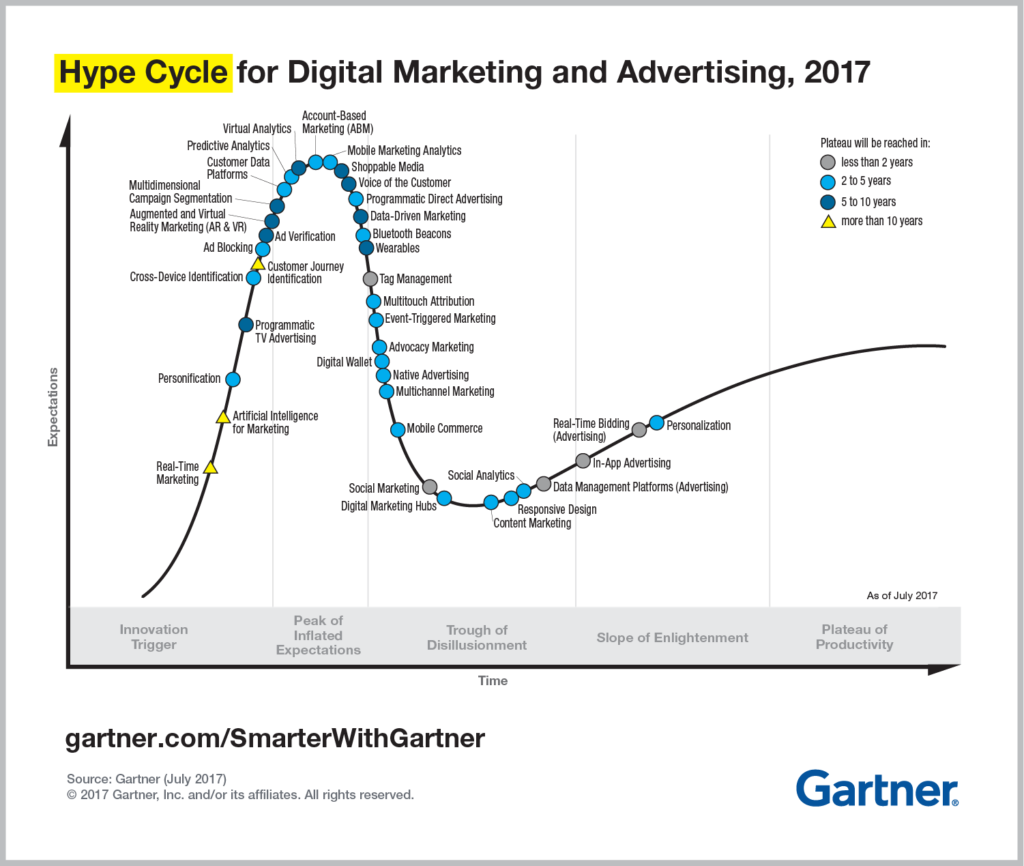Digital Marketing & Advertising: 5 Insights into the Gartner Hype Cycle
Digital Marketing is changing constantly. There are many factors to consider, including artificial intelligence (AI), data management and the relationship between MarTech and AdTech. All of these topics appear in the “hype cycle” in Digital Marketing & Advertising from Gartner. We explain what exactly lies behind the “hype cycle” with current examples of analyst Gartner.
The Gartner CMO Strategy Survey 2017 sees customer experience, customer retention and growth as key strategies to support marketing outcomes over the next 18 months. As a result, marketers are exploring technologies that can unify and expand customer data so that they serve as a good basis for communication. Think of your Sales Managers or Marketing: For any interaction with a customer, data must be equally captured and supplemented, no matter which department. These key insights from the 2017 Hype Cycle for Digital Marketing and Advertising allow marketers to prioritize investments in marketing technologies that support, in particular, data-driven customer experiences. But what exactly lies behind it?
Gartner’s Hype Cycle. (Picture: Gartner)
Gartner’s hype cycle shows the stages of public attention that a new product undergoes when it enters the market. Gartner also calls this the “curve of innovation”. The Hype Cycle was coined in 1995 by the Gartner, Inc. research group to better classify innovation technologies. But what exactly does the hype cycle represent?
Basically, it shows when a technology becomes relevant and when first steps become business-savvy approaches. As a result, the degree of attention and the time elapsed since the announcement of an innovation are compared. The stages of development that innovation undergoes are the “Innovation Trigger”, the “Peak of Inflated Expectations”, the “Trough of Disillusionment”, the “Slope of Enlightenment” and the “Plateau of Productivity.”
The already mentioned trend topics in Digital Marketing & Advertising can be transferred to this graphic. Thus, as a marketer, one can accurately estimate in which phase a trend of one’s company currently is.
1. Transformational technologies require exploration – and patience
Real-time marketing, artificial intelligence for marketing and customer journey analysis will bring more power and adaptability to help marketers collaborate effectively with prospects and customers. Although these three technologies are transformative and still in the innovation trigger phase, they will take ten or more years to mature. The next decade will require a lot of research and experimentation.
Action items:
- Real-Time Marketing: Rethink how you are organized. Building an organization with agility, responding faster to change than competitors is more practical than trying to make predictions.
- Artificial Intelligence for Marketing: Start learning more about AI now, and engage directly with your suppliers to understand the role it currently plays.
- Customer Journey Analytics: Start with customer identification and travel mapping through just two or three channels where data is available and valuable.
You might need assistance with successful real-time marketing?
2. AI invades marketing
AI is a common thread that runs through the whole marketing and advertising technology landscape. Marketing AI includes systems that change behaviors without being explicitly programmed based on collected data, usage analysis and other observations. They include technologies such as machine learning, deep learning, and natural language processing. AI-enabled technologies and techniques have the potential to transform marketing practices as we know them. The marketing area is in the innovation release phase and the providers promote the “intelligent” capabilities in their offers with different precision and truth. Define your claims and explore the possibilities of AI over the next decade.
Action item:
- AI for Marketing: Be careful with high standards of AI marketing. Establish test criteria and run pilots and proofs to verify such claims.
3. Marketers take control of data to enhance experiences
Customer Data Platforms (CDP) are close to peaking in inflation expectations, reflecting market participants’ desire to leverage first-party data across customer experience and to identify and leverage the most useful data to deliver compelling one-to-one engagements. The hype surrounding other data-driven marketing solutions is diminishing. Data management platforms are in the “Trough of Disillusionment” as marketers are currently facing challenges in integration and customization.
Action items:
- CDP: Treat this technology investment as an innovation system, as it is still in the process of being evolved and can be expected to converge with neighboring categories.
- Data Management Platforms: Do not convince yourself with third-party data to better apply first-party data for ad and content targeting.
4. MarTech und AdTech: An open relationship
The convergence of marketing and advertising technology translates into something that looks less like a marriage and more like an open relationship. However, there are still important connecting points between the two areas of identity and analytics. Cross-device identification enables potential customers and advertisers to respond to the height of inflated expectations when measuring mobile channels and associating ad impressions. Acceptance of account-based marketing has also increased dramatically as both new and existing customers have been reached on a large scale and the technology was at the height of inflation expectations.

Your employees should fully internalize Account-based Marketing (ABM). (Source: iStock / Weekend Images inc.)
Action items:
- Cross Device Identification: Marketing teams should investigate cross-device identification solutions to provide a deeper understanding of customers and prospects.
- Account-based Marketing (ABM): Ensure that sales, marketing and other executives are focused on and fully committed to the ABM program prior to evaluating the solution. This helps with integration and reporting.
5. Brand safety as a top digital advertising priority
Ensuring brand safety, adherence to visibility guidelines and preventing fraud are at the forefront of fears among major digital ad providers. While ad review is a new addition to the hype cycle, both ad blocking and ad review are entering the phase of excessive expectation. These problems motivate marketers to re-examine and realign their value exchange with the audience.
Action items:
- Ad blocking: Work with publishers on native solutions that complement and not just disrupt content experiences.
- Ad Verification: Identify and filter publishers with low ad standards and only report verified impressions.
[plista]



